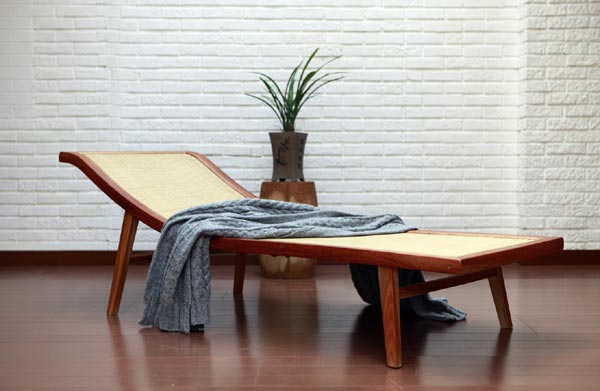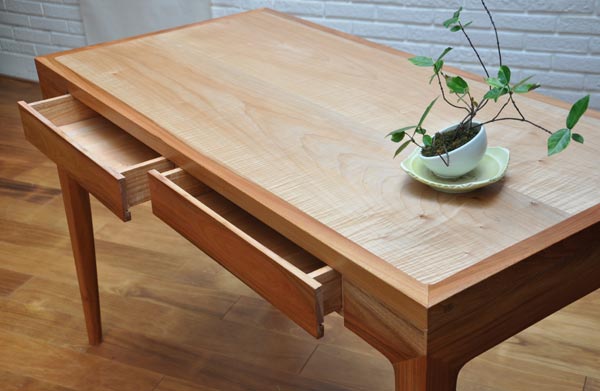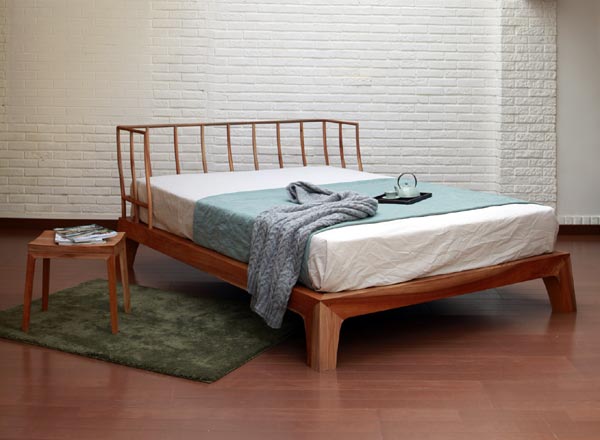
 |
|
Carved out of a single piece of wood, the lounge chair was shape like the Chinese word "zhi" as it would be written in calligraphy. Photos provided to China Daily |
 |
|
Pursuit of simplicity is the guiding principle in Chen's design. |
 |
|
Chen's latest design for a bed borrows the shape of a traditional Chinese comb. |
While ancient furniture remains an acquired taste, a young Chinese designer has given it a new breath of life. Chen Nan reports in Beijing.
Ancient Chinese furniture, especially from the early Qing and Ming dynasties, has a noble style that has survived the test of time.
But today, it appeals mainly to lovers of classic designs and collectors, who are willing to invest huge money in old furniture pieces, which are often made from valuable red sandalwood and rosewood.
A group of young Chinese designers is hoping to revive the interest in such antiques, by injecting traditional Chinese designs into contemporary furnishing.
This reinvented furniture is targeted at the younger consumers.
One of those designers is Chen Yanfei, 35, who owns Pu Su Furniture, a quaint shop hidden in a narrow alley of Changshu Lu, Shanghai. The store looks and feels more like a home rather than a shop selling furniture.
"The name Pu Su is borrowed from Zhuangzi (Chinese Taoist philosopher). It means 'plain, nothing could compete with its beauty'. It accurately expresses my furniture's style," Chen says.
The designer says he wants visitors who come into his shop to feel the connections between each piece of furniture. Even the decorative items are cleverly displayed. Borrowing from traditional Chinese culture icons such as tea sets, fans and ink paintings, the decorative items help to enhance the beauty of the furniture.
Chen's journey with the furniture and decorative items started some 10 years ago but he only managed to launch his own brand in June 2011, after a chance find of three furniture-making masters in Nantong city, Jiangsu province, in 2010.
"They have inherited the best skills from the older generations and they know what I want the moment they see my design drafts," says Chen, a graphic art design graduate from Guangzhou Art Institute.
Before opening Pu Su Furniture, he conducted market research and found that the idea of reviving traditional Chinese furniture is not new and had been done by other designers some years ago.
If he wants his designs to stand out, he needed to be different.
"Reviving our ancestors' perfect design needs courage. I don't want to copy the traditional furniture or just make small changes, such as alter the color and size," he says. "I want to make revolutionary Chinese furniture, which is traditional and at the same time, contains modern elements and individual wisdom."
The idea of incorporating Chinese calligraphy came to mind. He says calligraphy never bores him. Chen says he has studied Chinese traditional calligraphy since he was 4 years old, which cultivated his interests in traditional Chinese culture and influenced his furniture design. He loves the lines, strength and the culture in the ancient art form.
"I love drafting my design by using Chinese ink and writing brush, which provide inspirations," he adds.
The lines of his chairs, for example, resemble calligraphy strokes smooth, balanced and harmonious. All of his furniture designs have some form of rhythms, just like calligraphy, which combines bold and thin strokes. "I want to share my classic aesthetic view through my furniture designs," he says.
With consumers placing high demands on the practical value of furniture, Chen's furniture is also high on functionality. For example, a modern-day TV cabinet is given a classic look with details from traditional Chinese furniture, such as holders and feet, to enrich the design.
"The furniture I design is not just furniture, but pieces of artwork. When you put a closet in your bedroom, it's not simply a container but a delightful decoration," Chen says.

While Chen focuses on designing, he leaves the marketing and management of his company to his partner.
To promote his best work, Chen will move some of his designs from his Shanghai store to be displayed at Ullens Center for Contemporary Art on Aug 19 and give a speech there about his design concepts. He will be exhibiting 10 pieces of his latest furniture, priced from 3,000 yuan to 10,000 yuan, at China International Furniture Expo, from Sept 11-15 in Shanghai.
Chen has a team of interior designers to create tasteful homes for young Chinese intellectuals, who value high quality of life and individualism.
"In ancient China, the house is culture-filled from the furniture to decoration, clothes and accessories. Everything in the house is like an exhibition item," says Liu Feng, one of the founding members of China Furniture Design Brand Alliance, she is a sculpture graduate from the Academy of Art & Design, Tsinghua University.
"More Chinese designers are switching from Western designs to traditional Chinese motifs. The consumers, especially the younger generations, are also increasingly interested in Chinese original design and traditional Chinese culture."